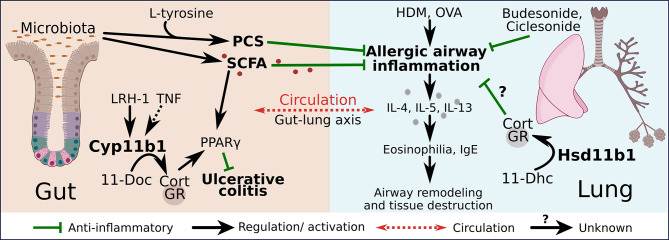Figure 1.
Regulation of type 2 responses by GCs along the gut-lung axis. The production of gut–derived GCs is regulated by liver receptor homolog-1 (LRH-1) and inducible via tumor necrosis factor (TNF). 11β-hydroxylase (Cyp11b1) catalyzes the conversion of 11-deoxycorticosterone (11-Doc) to corticosterone (Cort). GC signaling induces the expression of peroxisome proliferating factor gamma (PPARγ), which exerts anti-inflammatory effects on ulcerative colitis. Short chain fatty acids (SCFA) and p-cresol sulfate (PCS) are produced by the gut microbiota and exert anti-inflammatory actions on allergic airway inflammation. House dust mite (HDM) or ovalbumin (OVA)–induced allergic airway inflammation leads to increased type 2 cytokine interleukin (IL)-4, IL-5, IL-13 release, airway eosinophilia, increased immunoglobulin E (IgE) levels and finally to airway remodeling and tissue destruction. Gut-derived PCS and SCFA as well as synthetic GCs (budesonide, ciclesonide) suppress the allergic airway inflammation. The lung produces GCs in an 11β-hydroxysteroid dehydrogenase (Hsd11b1)-dependent manner through the conversion of 11-dehydrocorticosterone (11-Dhc), which may contribute to the local regulation of allergic airway inflammation.

